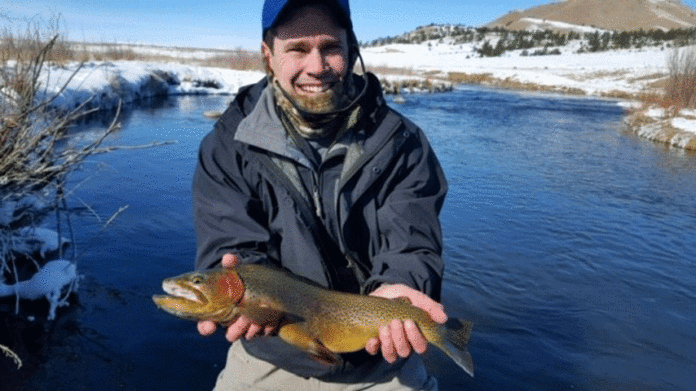Written by: Chip Swanson, Breckenridge Outfitters
Photos courtesy Chip Swanson
Many people are surprised when I mention I’m a year-round fly fishing guide up in Colorado’s high country. Sure, fishing in -15° can get cold, and snow blowing in your face presents challenges. But fish are still hungry and tailwaters are still flowing, no matter the weather or the season. I’m not saying that winter fishing is easy. It can be darn tough, and if you don’t know what you’re doing, one unsuccessful and cold day on winter waters will probably have you swearing off winter fishing for the rest of your life. Don’t give up! To increase your success, I offer up some of my go-to flies in winter tail waters. Remember, the size of flies is super important in the winter, so if you don’t have these sizes in your bag, do yourself a favor and visit your local fly shop or spend some time at the vise!
1. Zebra Midge (sizes 18-24)

Zebras pay the winter rent. This pattern just flat out puts fish in the net. Period. Colors I heavily use are black, brown, red, purple and olive. I tend to have lots of confidence in black and red. My go-to size is 22, followed by sizes 20 and 24, depending on the current hatch. I always carry the full size range in my bag. I literally tie hundreds of these in the winter. This is a great pattern to experiment with as well.
2. Top Secret Midge (sizes 20-24)

This Pat Dorsey fly is a great emerger imitation. I have had this fly produce in every tailwater in the West. I use the standard brown with white ribbing, but I also tie these up in black. You can dead drift these, swing them, or even fish them in the film. I use size 22 most often.
3. Bling Midge (size 18-24)

The first place I remember using this fly was down on the San Juan River in New Mexico. It worked so well that it has become a favorite. This is just a very simple thread midge with a tiny hot-spot flash collar. As far as colors, I use black, white, and red. The key to this is that it’s sparse and very low profile, tied on either a straight or curved hook in sizes 22 and 24 with 10-12/O thread.
4. Rainbow Warrior (size 18-20)

This is a fabulous attractor fly. I will also use this fly as a dropper behind egg patterns as a searching rig. I tend to use the Ranbow Warrior in red and pearl colors, but sometimes the black version works best. The flashy body wrap, the little movement in the small tail, and the glass bead that adds the sparkle and allure of a bubble on an emerging fly make this a great micro-attractor. If you tie, this is another great pattern to mess around with. Try different colors (like purple), use different materials, remove tails, or even add hot spots. I like to use size 18 and 20 hooks, since I’m using this as the “Come Eat at Joe’s” sign.
5. Double Down CDC Pheasant Tail (size 18)

This fly should be called the David Blaine or David Copperfield because it’s magic! It’s a cross between Randall Kauffman’s CDC Pheasant Tail and Charlie Craven’s Two-Bit Hooker. My fly boxes are packed with these in all sizes. That said, in winter I only use size 18. Yes, its a another damn Pheasant Tail, but it has the life-pulsing CDC wrapped collar that adds a plethora of magic. But the real dark magic here is that this fly is a slim double-beaded fly, so it sinks faster than my popularity in high school when I started driving a maroon ’78 Buick LaSabre. So unlike me and the Buick, it’s a great attractor and looks natural among its peers.
Chip Swanson, the 2019 Orvis-Endorsed Fly-Fishing Guide of the Year, works for Breckenridge Outfitters, in Breckenridge, Colorado.
Credit: Source link































